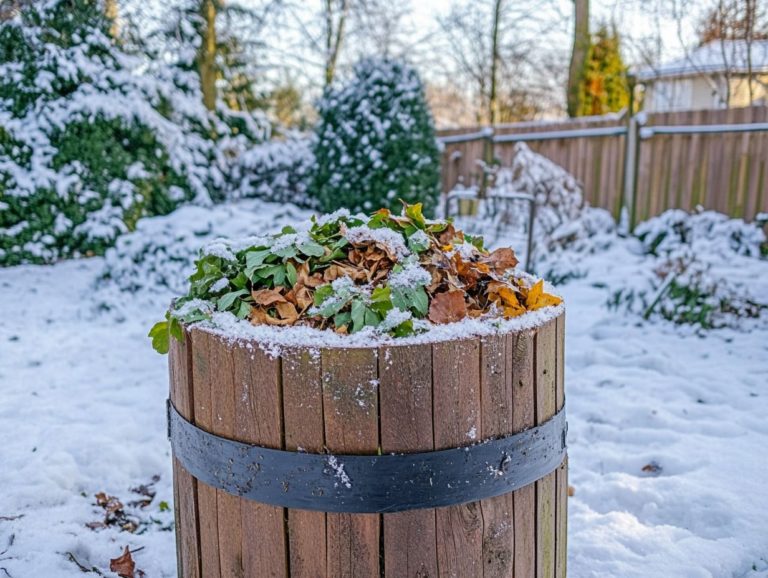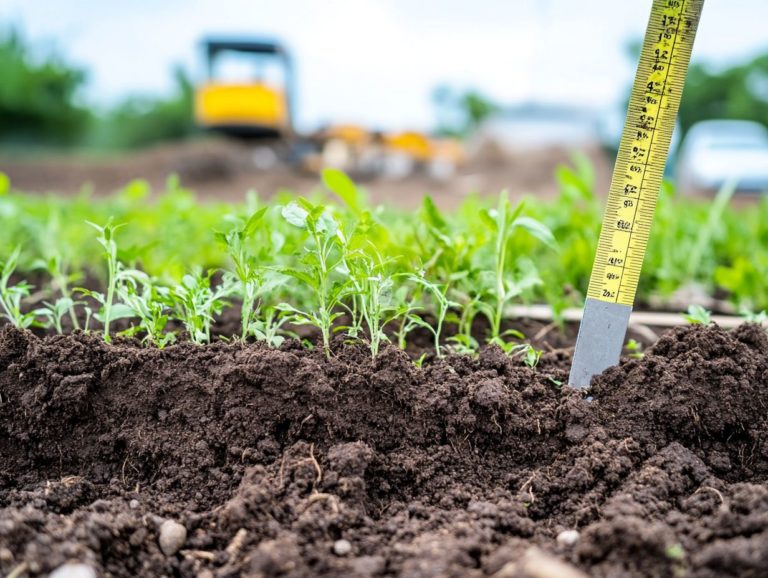Creating Raised Beds for Cold-Climate Gardening
Raised beds are a game-changer for gardeners, especially in colder climates. They create a controlled environment that enhances plant growth, improves drainage, and makes gardening more accessible and enjoyable.
This guide explores the benefits of raised beds. It helps you select the best location and discusses the ideal materials for construction. Additionally, it walks you through essential steps for preparing the ground, building and filling your beds, and maintaining them effectively.
Plus, you ll find valuable tips to extend your growing season. Embrace the journey and discover how to elevate your gardening experience!
Contents
- Key Takeaways:
- Benefits of Raised Beds
- Choosing the Right Location for Your Raised Beds
- Materials for Building Raised Beds
- Preparing the Ground for Raised Beds
- Building and Filling Your Raised Beds
- Caring for Your Raised Beds
- Extending the Growing Season with Raised Beds
- Frequently Asked Questions
- What materials are best for creating raised beds for cold-climate gardening?
- How deep should raised beds be for cold-climate gardening?
- Do I need to line my raised beds for cold-climate gardening?
- How should I fill my raised beds for cold-climate gardening?
- What are some benefits of using raised beds for cold-climate gardening?
- Can I use raised beds for cold-climate gardening in the winter?
Key Takeaways:
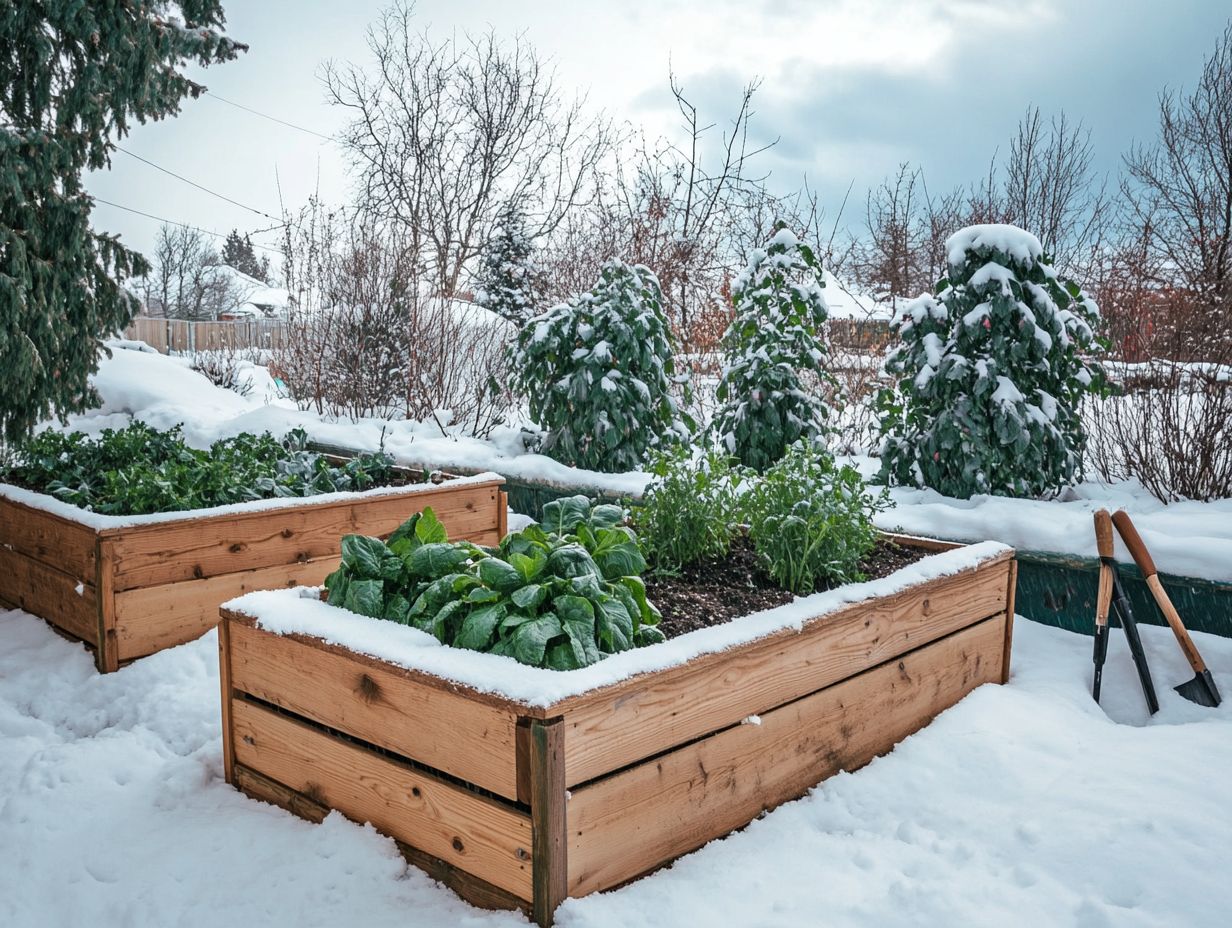
- Choose a sunny spot to maximize your harvest!
- Consider factors like sunlight, water access, and potential obstacles when selecting a location.
- Explore various materials for building raised beds, weighing their pros and cons regarding cost, durability, and sustainability.
Benefits of Raised Beds
Raised beds offer many advantages for gardeners, especially in cold climates like Wyoming and Alaska. They improve drainage, enhance soil warmth, and provide easy access for planting and harvesting.
By elevating your garden beds, you gain greater control over soil quality and can optimize your growing season. This also allows you to create a dedicated space for heirloom seeds and perennial plants, contributing to a flourishing garden environment.
You can also enrich these beds with additions to the soil that improve its quality and apply winter mulch. This ensures robust vegetable harvests, even in challenging conditions.
Choosing the Right Location for Your Raised Beds
Selecting the perfect spot for your raised beds is vital for successful gardening, particularly in colder climates where frost dates significantly affect plant development.
Think about these key factors to boost your garden’s success: sunlight, drainage, and accessibility to water sources. A location with at least six hours of sunlight and shelter from harsh winds can dramatically extend your growing season and increase yields, leading to a more rewarding vegetable harvest.
Factors to Consider
When planning your raised beds, several essential factors come into play, especially in cold climates where gardening conditions can be unpredictable. Consider the sunlight your plants will receive, the drainage capabilities of your soil, and your proximity to key gardening resources like water and tools.
Understanding how these factors interact can make a significant difference. For instance, sunlight is critical for photosynthesis. In chilly climates, maximizing sun exposure helps your tomatoes thrive, as they require full sun for robust growth. Leafy greens like kale can manage with partial shade, allowing you to diversify your plantings even in less-than-ideal lighting.
Proper drainage is crucial as well; overly wet soil can stunt growth and lead to root rot a common issue in colder regions where thawing frozen ground complicates drainage. By educating yourself on your local conditions, such as wind exposure and soil type, you can make informed decisions that enhance your garden’s productivity.
Materials for Building Raised Beds
Selecting the ideal materials for your raised beds is crucial for long-term gardening success, especially in colder climates where durability and insulation are vital. For detailed guidance, check out this resource on how to plan a cold-climate vegetable garden.
Common options include untreated wood, bricks, and composite boards, each offering unique advantages in terms of longevity, cost, and insulation properties.
Additionally, consider soil amendments and incorporating structures like cold frames or hoop houses to enhance the environment within your raised beds. This paves the way for a more fruitful growing season.
Options and Pros/Cons

When you re choosing materials for raised beds, you have a variety of options at your fingertips, each with its own set of advantages and drawbacks especially when it comes to longevity and soil health. Untreated wood is a popular pick because it s budget-friendly and easy to work with! However, you might find yourself replacing it sooner than you d like compared to more durable choices like bricks or composite boards.
It s essential to understand how these materials interact with soil boosters and contribute to your overall gardening success, particularly if you re aiming for a bountiful vegetable harvest.
Bricks, for instance, offer a robust and enduring option. They often elevate the visual appeal of your garden while standing strong against the elements. They may, however, fall short when it comes to insulating roots compared to wood or composite materials.
Speaking of composites, these eco-friendly options, made from recycled materials, strike a balance with their long-lasting nature and minimal maintenance needs.
The gardening techniques you choose will likely shift depending on the materials you select, as each one influences drainage, soil temperature, and nutrient retention. Being mindful of these factors can pave the way for a more productive and sustainable garden, ensuring you reap the rewards of your efforts! Are you ready to create your own thriving garden?
Preparing the Ground for Raised Beds
Preparing the ground for raised beds is an essential step in your gardening journey, guaranteeing that your plants thrive in the ideal soil conditions. Get ready for success! Begin by clearing the area of debris, leveling the ground, and possibly adding soil boosters to enrich the planting medium.
By taking these steps, you not only improve drainage but also elevate the overall health of your garden. This paves the way for a successful growing season in your local gardening endeavors!
Clearing and Leveling the Area
Clearing and leveling the area designated for your raised beds is essential to establishing a thriving gardening space, as it directly influences soil health and drainage. Start by removing any rocks, weeds, or debris that could impede plant growth! Then level the ground to create an even surface for your raised beds.
Investing time in planning your garden layout can significantly enhance growth potential. Once you ve defined your clear area, consider using a rake or shovel to achieve a smooth, flat surface that promotes even water distribution. Incorporating organic materials like compost or well-rotted manure enriches the soil and boosts its capacity to retain moisture and nutrients.
Adding boosters such as perlite or vermiculite can improve drainage, ensuring that roots have adequate access to oxygen. This thoughtful preparation lays a strong foundation for healthy plants, ultimately leading to a bountiful harvest!
Building and Filling Your Raised Beds
Building and filling your raised beds marks an exhilarating phase in your gardening journey! Transform your meticulously prepared space into a flourishing haven for plant growth. Begin by constructing the frame with your selected materials, ensuring it is not only secure but also perfectly aligned for optimal results.
Once the structure stands strong, fill the beds with a carefully curated blend of soil and boosters. This thoughtful mix can greatly enhance the health and growth of your plants, especially when you employ structures like cold frames to create an ideal temperature environment.
Step-by-Step Instructions
Creating raised beds involves several essential steps that will pave the way for a flourishing garden, especially in colder climates. For detailed instructions on how to build raised beds for cold-climate plants, begin by selecting your materials and constructing the frame to match your design preferences. Ensure it is securely anchored in place.
After assembling the frame, fill the beds with high-quality soil blended with the right amendments to foster rich soil for your plants.
Opt for untreated wood or recycled composite materials for the frame. This choice prevents harmful chemicals from leaching into the soil. Once the structure is firmly in place, focus on the soil composition.
A mix of topsoil, compost, and aged manure creates a well-draining yet moisture-retaining medium that your plants will thrive in. Assessing drainage is crucial; consider adding lightweight materials like perlite or vermiculite to improve aeration.
It’s also important to identify the specific nutrient needs of the plants you intend to grow. Adjust the amendments accordingly to support a robust root system. Regularly test the pH and nutrient levels to ensure your garden flourishes over time.
Caring for Your Raised Beds
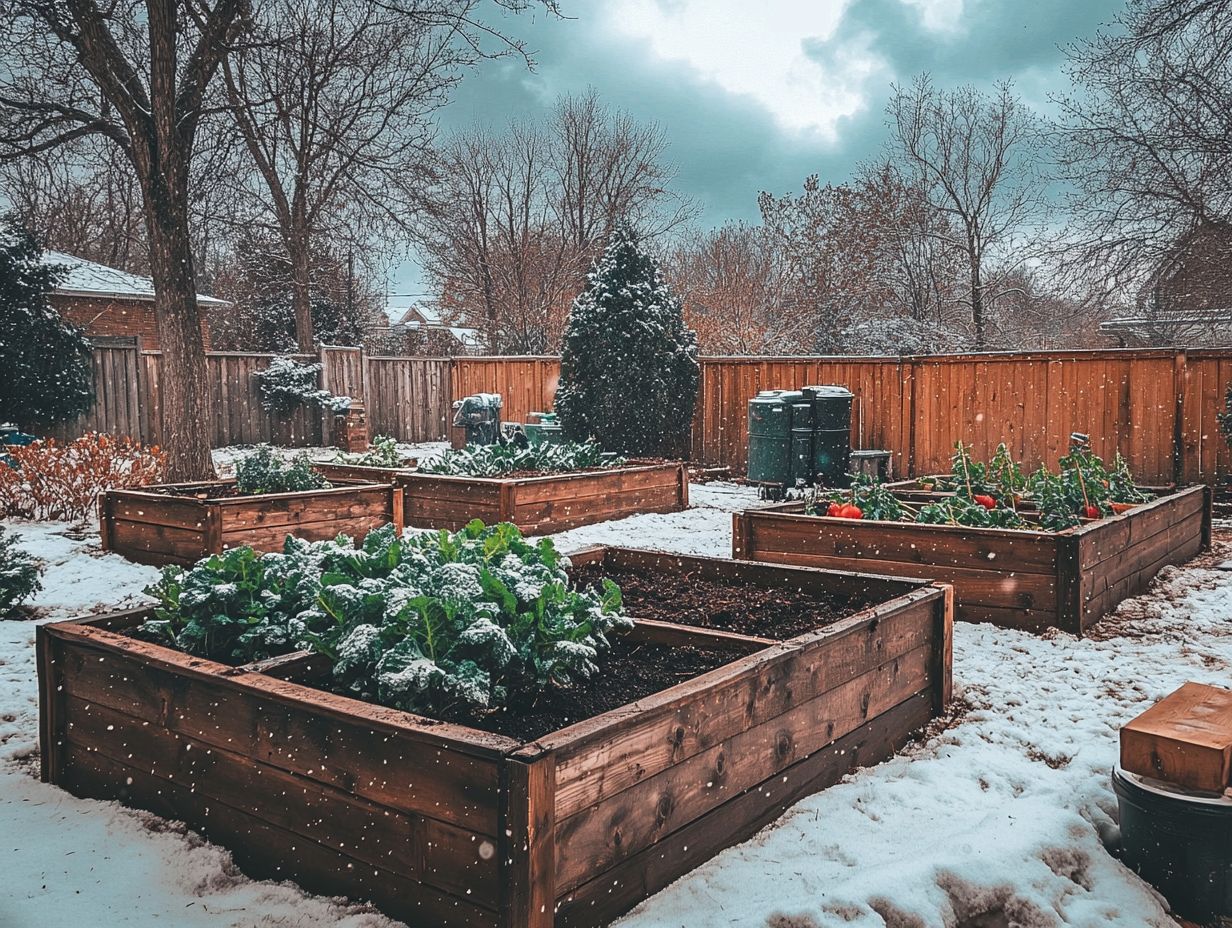
Caring for your raised beds is crucial for nurturing healthy plants and securing a fruitful harvest. This involves regular tasks like watering and weeding.
Establish a consistent watering schedule. Adapt it to the specific needs of your plants as they grow, particularly in colder climates where moisture retention might pose a challenge.
Proactive weeding and thoughtful soil amendments significantly boost the health and productivity of your garden.
Watering, Weeding, and Other Maintenance Tasks
Effective watering, weeding, and maintenance tasks are essential for the longevity and productivity of your raised beds. These tasks impact everything from plant health to vegetable harvest yields.
Establishing a regular watering schedule is vital. Consider factors like first and last frost dates to ensure your plants receive adequate moisture, especially in colder climates.
Regular weeding minimizes competition for nutrients. Incorporating soil amendments enhances soil quality and overall growth.
To optimize your watering, aim for early mornings or late afternoons. These times help reduce evaporation and allow your plants to absorb moisture more efficiently. Utilizing drip irrigation a method that delivers water directly to the plant roots and soaker hoses targets the roots without wetting the foliage, helping prevent disease.
For weeding, hand-pulling young sprouts is often effective. Don’t overlook the power of mulching. Mulch creates barriers against weeds while nourishing the soil over time.
Adding organic matter like compost or aged manure dramatically improves soil structure, encourages microbial activity, and enhances nutrient availability, leading to healthier plants and a more fruitful harvest.
Extending the Growing Season with Raised Beds
Get ready to extend your growing season and supercharge your garden! This method significantly boosts your vegetable harvest potential, even during the off-season.
By incorporating season extenders like cold frames and hoop houses, you can create a warmer microenvironment. This protects your plants against harsh weather conditions and allows you to start seeds earlier in the spring.
Embracing this approach maximizes your local gardening efforts and enriches the variety of crops you can cultivate throughout the year.
Start building your raised beds today to enjoy a bountiful garden all year round!
Tips for Cold-Climate Gardening
Cold-climate gardening brings its own set of challenges, but with the right tips and techniques, you can enjoy a fruitful growing season using raised beds! Begin by selecting cold-hardy plants such as kale, spinach, and mustard greens that thrive in lower temperatures. Additionally, improving soil structure for cold-weather gardens will enhance your vegetable harvest significantly.
Consider using season extenders like row covers or tunnels to shield sensitive crops from frost. This enables you to plant earlier and extend your harvesting period.
Incorporating perennials, or plants that come back year after year, such as rhubarb or certain herbs, can also be a game-changer. They offer reliable yields with minimal effort on your part. To truly maximize your garden s potential, think about layering your planting for overlapping harvest times. This ensures a continuous supply throughout the growing months.
Don t overlook mulching! It not only insulates the soil but also conserves moisture, making it easier for these resilient varieties to thrive even as temperatures drop.
By approaching your cold-climate gardening endeavors with thoughtfulness and strategy, you can cultivate a vibrant oasis that stands resilient against seasonal challenges.
Frequently Asked Questions
Here are some common questions about cold-climate gardening.
What materials are best for creating raised beds for cold-climate gardening?
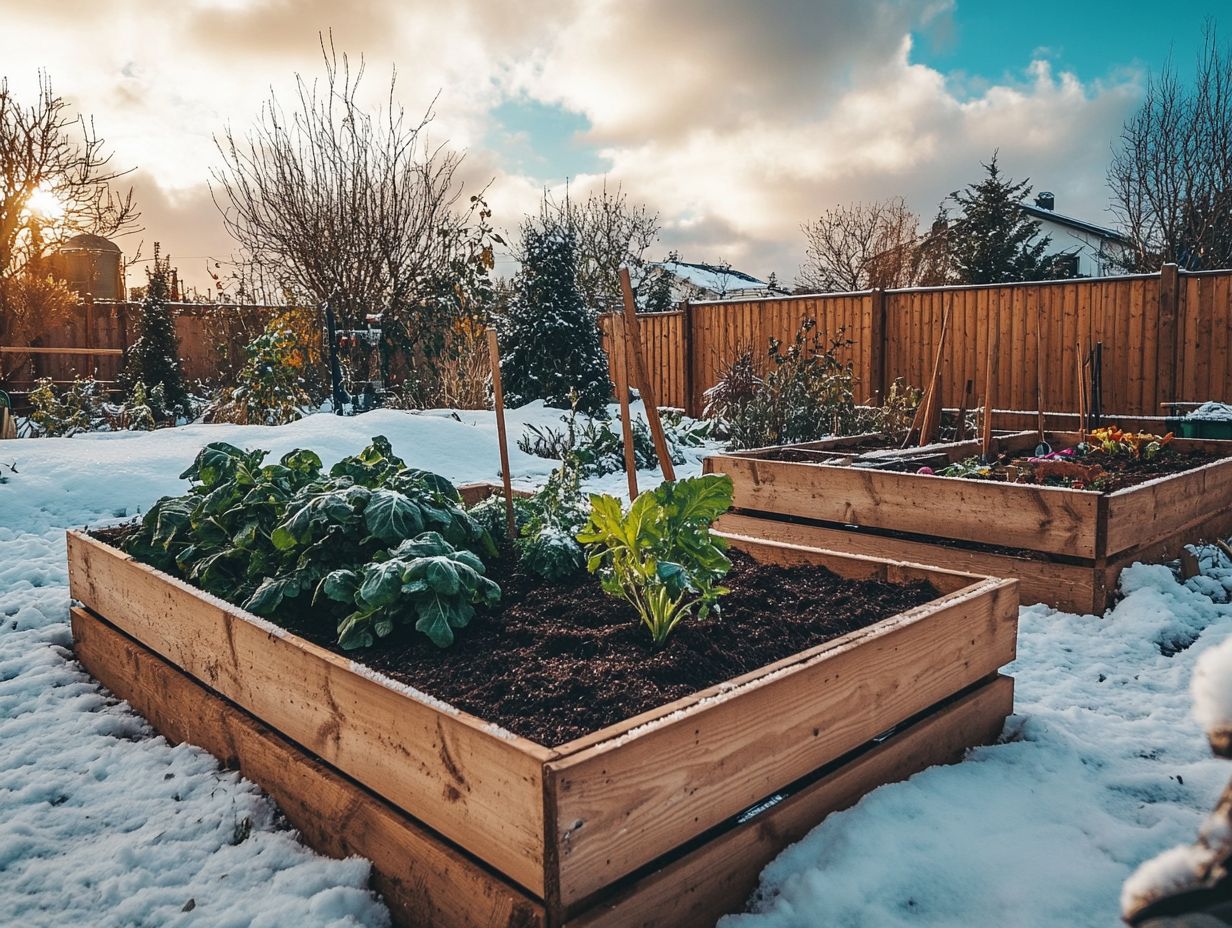
The best materials for creating raised beds for cold-climate gardening are durable, weather-resistant, and will not rot easily. Some good options include cedar, redwood, and pressure-treated lumber. For soil preparation for container gardening in cold climates, you can also use concrete blocks or stones, but be sure to insulate them to prevent the soil from freezing.
How deep should raised beds be for cold-climate gardening?
The depth of your raised beds will depend on the type of plants you will be growing. Generally, they should be at least 12 inches deep, but for root vegetables or larger plants, consider making them 18 inches deep. This provides enough room for the roots to grow and insulates them from the cold.
Do I need to line my raised beds for cold-climate gardening?
Lining your raised beds is not necessary, but it can help with insulation and prevent weeds from growing up through the bottom. If you choose to line them, use a heavy-duty landscape fabric or plastic sheeting. Make sure to leave drainage holes to prevent water buildup.
How should I fill my raised beds for cold-climate gardening?
The best way to fill your raised beds is with a combination of topsoil, compost, and organic matter. This will provide a nutrient-rich environment for your plants to grow. You can also add a layer of mulch on top to help retain moisture and regulate temperature.
What are some benefits of using raised beds for cold-climate gardening?
- Better drainage
- Improved soil quality
- Easier maintenance
- Warm up faster in the spring, allowing for earlier planting
- Extend your growing season in the fall by insulating the soil
Can I use raised beds for cold-climate gardening in the winter?
Yes, you can use raised beds for cold-climate gardening in the winter. To protect your plants from freezing temperatures, cover the beds with a layer of mulch or straw. Additionally, consider using a cold frame for winter gardening to extend the growing season even further.
Start your cold-climate gardening today and watch your garden flourish!

